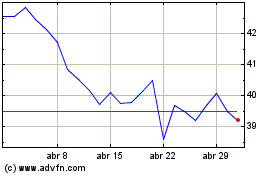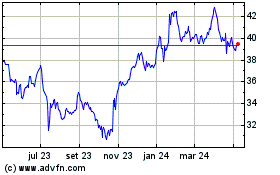Methodology for the WSJ's Study of Broadband Bills
24 Dezembro 2019 - 12:29PM
Dow Jones News
The Wall Street Journal examined information from more than
3,300 bills for its study of broadband pricing across the U.S. We
excluded more than 600 bills that didn't specify an internet price
and used 2,694 bills for our analysis.
We used 377 bills that were directly submitted to the WSJ by
individuals and 183 bills provided by BillFixers. Data from 2,134
bills was provided by Billshark. BillFixers and Billshark redacted
names and personally identifying information. Both firms help
consumers negotiate better rates with cable and telecommunications
providers.
We examined bills from 54 different broadband providers. Most of
the bills came from Charter Communications Inc. (1,024), Comcast
Corp. (705), AT&T Inc. (232) and Verizon Communications Inc.
(197), four of the biggest broadband providers in the U.S. ( Read
our analysis here.)
To compare internet prices, we used the internet cost as listed
on consumer bills plus any internet-related fees, including modem
rentals, speed surcharges and data-usage fees. We excluded taxes
and one-time fees, such as installation fees or late fees. For
bundle bills, we excluded noninternet services and fees.
There were bills from all 50 states and 2,155 different ZIP
Codes. The Journal used demographic data from the Census Bureau's
American Community Survey to split bills depending on the ZIP Code
and their demographic composition. The analysis looked at median
household income and population density. Multiple bills fit into
one or more demographic groups and were taken into account as part
of each group analysis.
Rural ZIP Codes were defined as those with a population of less
than 100 per square mile. Urban ZIP Codes were defined as those
with a population of 10,000 per square mile or more. High-income
ZIP Codes were defined as those with a median household income of
$90,000 or more. Low-income ZIP Codes were defined as those with a
median household income of $30,000 or less. There were at least 150
bills from each of these categories.
Address-level competition data was provided by Billshark and
obtained through Allconnect, an online marketplace for home
services. Competitive areas were defined as those in which
subscribers could get the same service from more than one cable or
fiber broadband provider. DSL service wasn't considered a
competitive option for high-speed broadband.
--Inti Pacheco and Shalini Ramachandran
(END) Dow Jones Newswires
December 24, 2019 10:14 ET (15:14 GMT)
Copyright (c) 2019 Dow Jones & Company, Inc.
Verizon Communications (NYSE:VZ)
Gráfico Histórico do Ativo
De Abr 2024 até Mai 2024

Verizon Communications (NYSE:VZ)
Gráfico Histórico do Ativo
De Mai 2023 até Mai 2024
